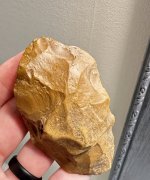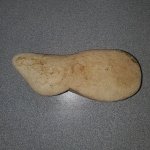kenb
Bronze Member
By CARRIE PEYTON DAHLBERG
THE SACRAMENTO BEE
last updated: August 18, 2007 02:35:22 AM
SONORA — Robert Ward climbed out of his pickup and ambled toward four guys gathered around the front porch of a Tuolumne City house.
"I'm researching a big meteor that blew up near here," he began.
Before he left a few minutes later, the guys knew how to contact him, that he'd pay for meteorites, and that he wanted to meet with anyone who'd seen the dazzling flare above Tuolumne County last weekend.
Ward had driven hard from Arizona lured by that fireball, a brilliant, booming event that shook houses, awakened families and jangled telephones for sheriff's dispatchers.
He was hunting treasure: ancient space rocks, newly fallen to Earth.
To call Ward's quest a long shot understates it.
Of the hundreds of meteors each year that flare brightly enough and break apart loudly enough to prompt multiple calls to authorities, only a few worldwide lead to meteorite finds, said University of Arkansas meteor expert Derek Sears.
On top of that, Ward's search had led him to country ranging from rolling, oak-studded foothills to heavily forested Sierra peaks. A missing person's car can languish undiscovered for months there, Tuolumne County Sheriff's Lt. Dan Bressler said.
Ward hoped to narrow his search by persuading witnesses to stand with him exactly where they saw the fireball, and show him its arc through the sky. He took measurements with an azimuth compass and noted his position with a global positioning system, gathering data to put into mapping software.
"I've talked with witnesses on three sides now, north of it, south of it and east of it," he said late Thursday afternoon, on his first full day in California.
Ward is among a growing cadre of meteorite collectors, a field that has boomed with the Internet and improved hunting technologies.
"I've never been involved in a group that was so passionate and obsessive about their hobby," said Geoffrey Notkin, an Arizonan who has bought, sold and searched for meteorites for 15 years.
While many people devote occasional weekends to the hobby, a few make a living, mostly traveling to known sites in deserts or ice fields strewn with meteorites that fell long ago. They search there, using sophisticated metal detectors.
"The most successful hunters are bold and determined and willing to spend a lot of time," Notkin said.
Ward, at 30, qualifies for at least two out of three. He describes himself as an investor, who has meteorites on display in every room of his house in Prescott, Ariz., and who rarely sells his finds.
Fireball 'lit up the entire sky'
The burst of light that drew Ward to Sonora was not the streak of a typical falling star, but its much brighter cousin, called a fireball.
While not rare, a fireball "is so spectacular we are poorly calibrated to handle it," said Sears, director of the Arkansas Center for Space and Planetary Sciences. People often remember the objects as closer, brighter and slower than they really were.
Even among fireballs, this one stood out, said Robert Lunsford, operations manager of the American Meteor Society, who keeps the society's fireball log.
"This is one of the top 10 events I've had since I began recording back in 2005," he said, because so many observers mentioned a delayed sonic boom.
Just after midnight on Aug. 11, it was seen from Fair Oaks to San Francisco to Gilroy, and filmed by a Yuba City sky watcher, but the fireball made its most dramatic appearance above Tuolumne County.
"We got reports from all ends of the county," Bressler said. "It was either bright blue or bright green. It lit up the entire sky. It lit up Lake Melones so somebody could see every boat on the lake. The houses shook."
'It was pretty wild'
Every deputy on patrol called in, 911 lines were flooded briefly, and over a 24-hour period, dispatchers handled 200 more calls than usual.
"It was pretty wild," said sheriff's Cpl. Kelly Dickson, who was driving home when the sky above his truck lit up twice. "I saw the object explode up in the sky; a couple of fragments that were still glowing split off. One was headed east and the other was headed in a northerly direction."
From Dickson's description, Sears concluded the sheriff's officer probably was close to the retardation point, where a speeding meteor hits denser atmosphere like a rock slamming into a wall. The force shatters the rock along its cracks, and whatever reaches the Earth's surface is called a meteorite. Often, consumed by heat, nothing is left to fall.
Science still has "tons and tons" to learn from meteorites, Sears said. Although they've been probed extensively in labs, "almost yearly something new turns up." Some of the rarest meteorites come from the moon or Mars, and others from comets, but most are believed to speed toward Earth from the asteroid belt, where rocks owe their origin to the beginning of the solar system.
"You're holding a rock in your hand that's 4 billion years old, that formed when we barely had an Earth," Sears said, adding that meteorites still give him goose bumps. "There are sprinklings in there of dust from other star systems
http://www.modbee.com/local/story/45981.html
kenb
THE SACRAMENTO BEE
last updated: August 18, 2007 02:35:22 AM
SONORA — Robert Ward climbed out of his pickup and ambled toward four guys gathered around the front porch of a Tuolumne City house.
"I'm researching a big meteor that blew up near here," he began.
Before he left a few minutes later, the guys knew how to contact him, that he'd pay for meteorites, and that he wanted to meet with anyone who'd seen the dazzling flare above Tuolumne County last weekend.
Ward had driven hard from Arizona lured by that fireball, a brilliant, booming event that shook houses, awakened families and jangled telephones for sheriff's dispatchers.
He was hunting treasure: ancient space rocks, newly fallen to Earth.
To call Ward's quest a long shot understates it.
Of the hundreds of meteors each year that flare brightly enough and break apart loudly enough to prompt multiple calls to authorities, only a few worldwide lead to meteorite finds, said University of Arkansas meteor expert Derek Sears.
On top of that, Ward's search had led him to country ranging from rolling, oak-studded foothills to heavily forested Sierra peaks. A missing person's car can languish undiscovered for months there, Tuolumne County Sheriff's Lt. Dan Bressler said.
Ward hoped to narrow his search by persuading witnesses to stand with him exactly where they saw the fireball, and show him its arc through the sky. He took measurements with an azimuth compass and noted his position with a global positioning system, gathering data to put into mapping software.
"I've talked with witnesses on three sides now, north of it, south of it and east of it," he said late Thursday afternoon, on his first full day in California.
Ward is among a growing cadre of meteorite collectors, a field that has boomed with the Internet and improved hunting technologies.
"I've never been involved in a group that was so passionate and obsessive about their hobby," said Geoffrey Notkin, an Arizonan who has bought, sold and searched for meteorites for 15 years.
While many people devote occasional weekends to the hobby, a few make a living, mostly traveling to known sites in deserts or ice fields strewn with meteorites that fell long ago. They search there, using sophisticated metal detectors.
"The most successful hunters are bold and determined and willing to spend a lot of time," Notkin said.
Ward, at 30, qualifies for at least two out of three. He describes himself as an investor, who has meteorites on display in every room of his house in Prescott, Ariz., and who rarely sells his finds.
Fireball 'lit up the entire sky'
The burst of light that drew Ward to Sonora was not the streak of a typical falling star, but its much brighter cousin, called a fireball.
While not rare, a fireball "is so spectacular we are poorly calibrated to handle it," said Sears, director of the Arkansas Center for Space and Planetary Sciences. People often remember the objects as closer, brighter and slower than they really were.
Even among fireballs, this one stood out, said Robert Lunsford, operations manager of the American Meteor Society, who keeps the society's fireball log.
"This is one of the top 10 events I've had since I began recording back in 2005," he said, because so many observers mentioned a delayed sonic boom.
Just after midnight on Aug. 11, it was seen from Fair Oaks to San Francisco to Gilroy, and filmed by a Yuba City sky watcher, but the fireball made its most dramatic appearance above Tuolumne County.
"We got reports from all ends of the county," Bressler said. "It was either bright blue or bright green. It lit up the entire sky. It lit up Lake Melones so somebody could see every boat on the lake. The houses shook."
'It was pretty wild'
Every deputy on patrol called in, 911 lines were flooded briefly, and over a 24-hour period, dispatchers handled 200 more calls than usual.
"It was pretty wild," said sheriff's Cpl. Kelly Dickson, who was driving home when the sky above his truck lit up twice. "I saw the object explode up in the sky; a couple of fragments that were still glowing split off. One was headed east and the other was headed in a northerly direction."
From Dickson's description, Sears concluded the sheriff's officer probably was close to the retardation point, where a speeding meteor hits denser atmosphere like a rock slamming into a wall. The force shatters the rock along its cracks, and whatever reaches the Earth's surface is called a meteorite. Often, consumed by heat, nothing is left to fall.
Science still has "tons and tons" to learn from meteorites, Sears said. Although they've been probed extensively in labs, "almost yearly something new turns up." Some of the rarest meteorites come from the moon or Mars, and others from comets, but most are believed to speed toward Earth from the asteroid belt, where rocks owe their origin to the beginning of the solar system.
"You're holding a rock in your hand that's 4 billion years old, that formed when we barely had an Earth," Sears said, adding that meteorites still give him goose bumps. "There are sprinklings in there of dust from other star systems
http://www.modbee.com/local/story/45981.html
kenb




